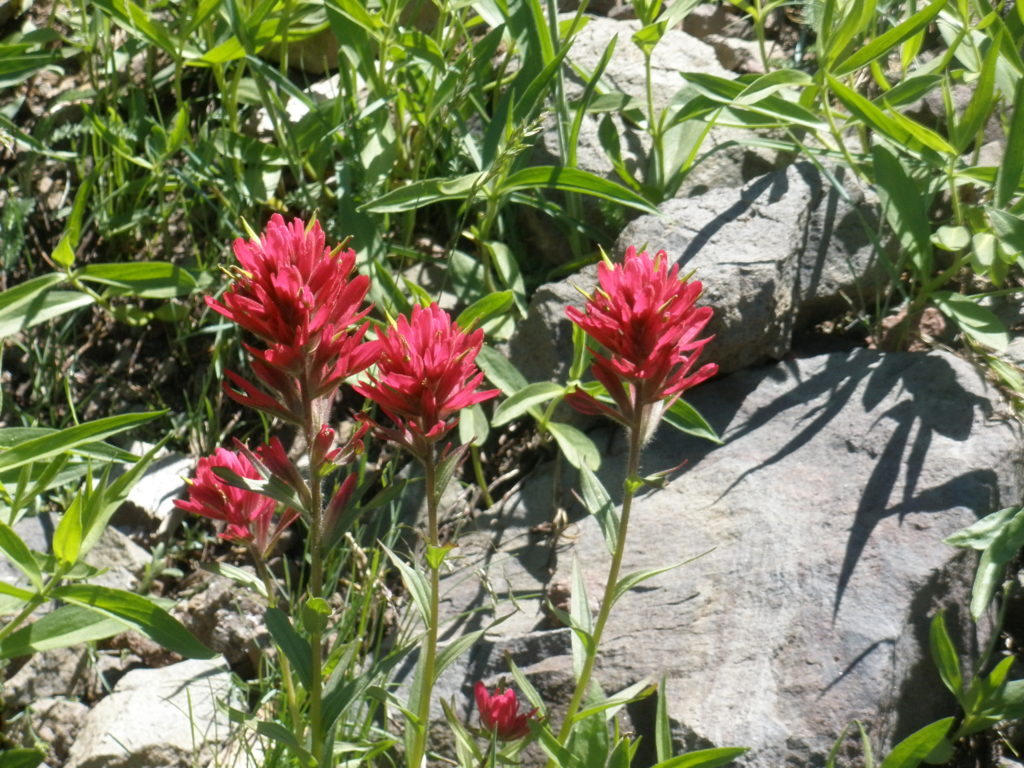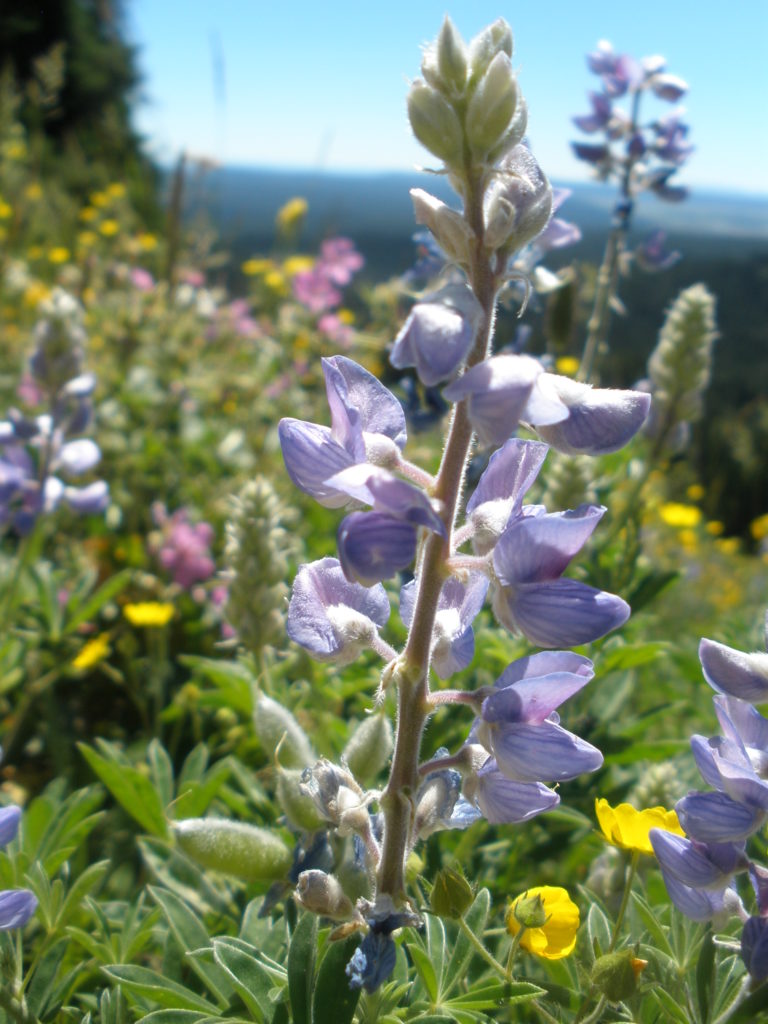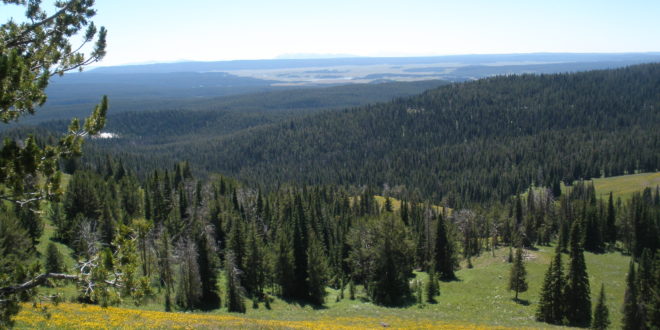The flowers on Yellowstone’s Mount Washburn trail are the best “fireworks” around—blue, yellow, pink, purple, magenta carpeting the hills and trailsides.
Real fireworks aren’t allowed in the Park, of course, which, coupled with the fact that a lot of people still like to be at home for the holiday, can make the Fourth of July feel a little less busy than the rest of the summer.
I set out early with a couple I’ve been friends with for a long time. We made good time from Mammoth Hot Springs, traveling to Canyon via Norris. There’s road construction north of Roaring Mountain, but the crews had the holiday off, so we weren’t delayed.

Road construction
The Park website says to expect up to half-hour delays on this stretch during the day through Sept. 11, with some night closures from 10 a.m. to 7 p.m. possible later this summer. The road will be closed from Sept. 12 to Oct. 7, but the Indian Creek and Norris campgrounds will still be open. The detour will be over Dunraven Pass, between Canyon and Tower. The interior Park roads close for the season Nov. 7. The road from Mammoth to Cooke City stays open all year.
We got to Canyon and made a last pit stop at the visitor center “in porcelain,” as my friend Debbie always calls a real restroom versus a vault toilet outhouse, before heading up to the Dunraven Pass trailhead.
Save some elevation gain from Dunraven trailhead
I prefer the Dunraven trailhead to the Chittenden trailhead, located a few miles north toward Tower Junction, because I think the scenery and flowers are prettier. Plus I’m lazy, and if you start at Dunraven, elevation 8,850 feet, you’ll save a 100 feet of elevation gain on the way to the summit/fire lookout at 10,243 feet. I hiked up the Chittenden side last summer and found those long, gradual grades that never seem to end demoralizing. The Dunraven side’s switchbacks seemed shorter.
Washburn is one of the Park’s most popular dayhikes—not too long (a little over 6 miles roundtrip), following an old road (so it’s really hard to get lost), and there’s a terrific payoff in 360-degree views all across the Park from the enclosed observation area at the top.
There was even a little snow near the top, a small patch just off the trail. Someone had built a couple of small snowmen. Some kids came up behind us and jumped on it.
“Look, Mom! Snow on the Fourth of July!” they yelled.
‘It’s a bit blowy’
A little farther up, rain blew in from the southeast and the wind tried to push us around a bit just below the summit. I had to engage the hurricane strap of my sun hat and tuck in the chest strap on my daypack to keep it from whacking me in the face.
Several years ago, on a hike up Avalanche Peak, a friend and I encountered similar wind and near-rain conditions. We had just bundled up for the ascent and tightened up our loose hats and straps, when two British women came down the trail toward us. With perfect English understatement they announced, “It’s a bit blowy up top.” It’s become a catchphrase now for any gale-force winds.
Debbie’s husband, Rick, had to step into the vault toilet at the summit to have any chance of lighting a cigarette. This may be one case where no one could object to cigarette smoke, which could only improve the smell inside an outhouse.
The rain wasn’t heavy and it moved on. We put on a layer and after a brief snack in the observation area, we headed back down the trail.
Bear spray
There were plenty of other hikers, but not so many to feel crowded. Many were carrying bear spray, but certainly not most. Park officials launched a bear-spray awareness campaign this spring after research revealed that only about 15 percent of backcountry hikers were carrying it, a University of Montana researcher told us when we returned to the parking lot. Park experts say carrying bear spray is one of the most important things people can do to help protect themselves from bears in Yellowstone’s backcountry.
The researcher said a grizzly sow with cubs had been seen frequently in the meadows near Mount Washburn, and we’d actually caught a glimpse of her out in the open above the road north of Canyon Junction on our way to the Dunraven trailhead. When we saw her, she was headed away from Mount Washburn and was a couple of miles from our destination. We scanned the distant hillsides for her once we gained some elevation, but didn’t see her again.
For the record, I was carrying, but the researcher scolded me for not having it immediately accessible. It was in my pack’s outer side pocket, which takes a few seconds of fumbling to reach around and grab. Not so handy when seconds could matter in a sudden bear encounter.

And people-watching
I love to people-watch in Yellowstone—after all the years I’ve spend around here, the human animal never ceases to entertain.
On the way down, we met up with an East Indian family on the way up. The young dad and the older of two young boys were headed uphill, but the mom and a younger boy, riding piggyback, were headed downhill. From the sound of things, Dad wanted Mom and the younger boy to turn around and head uphill. But Mom was apparently having none of it.
They were probably less than a mile from their car, but that section of trail has some steep bits, and it was looking more and more like rain. They had light jackets and Dad was carrying a small backpack. I could see one little box of what looked like Costco coconut water sticking out of the pack.
We passed Dad and the older boy, who couldn’t have been more than 8, and then caught up with Mom and the younger boy, who was maybe 4, tops. She had just put him down to walk, and he was unhappy about that. I tried to catch her eye. I wanted to tell her she was doing the right thing, but decided to stay out of it. The older boy zoomed past us, headed downhill, a few minutes later. I’m glad they didn’t try to drag those little kids on a 6-mile walk. And I’m sure they weren’t carrying bear spray.
We got back to Canyon Village in time for some thunder and lightning and a downpour. We dashed into the General Store like every other human in the area trying to get in out of the rain. We bought some hot beverages and headed out.
By the time we got back to Mammoth, it was sunny and warm again. A number of mama elk and their little ones were having a lie-down on the grassy, shaded traffic median in front of the Post Office. It looked like nap time at a play date. They were attended by one young male, who had a 3 or 4-point rack half-grown in lush brown velvet. The little ones, some still with their Bambi-like baby spots, were napping hard.
The humans nearby were keeping their distance, behaving for a change. I wondered if the grassy shade was nice enough to make up for all the noisy, goofy humans.
I got back to Livingston in plenty of time to catch some “real” fireworks, but the “flowerworks” display on Mount Washburn is always better.
 Yellowstone Insider Your Complete Guide to America's First National Park
Yellowstone Insider Your Complete Guide to America's First National Park






You must be logged in to post a comment.